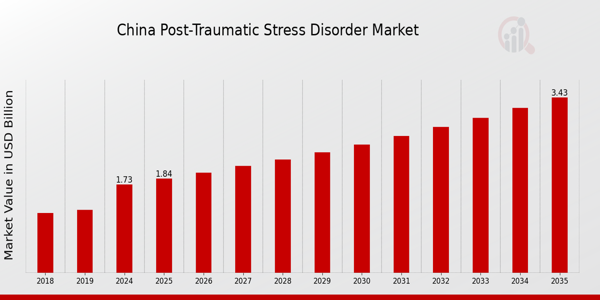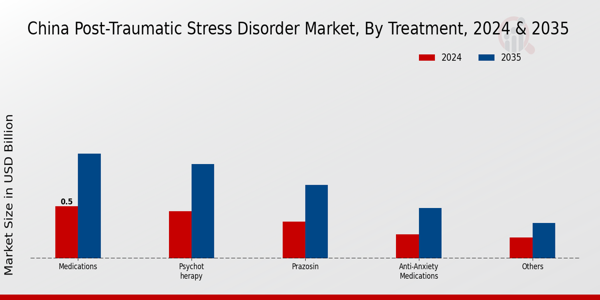China Post-Traumatic Stress Disorder Market Overview
As per MRFR analysis, the China Post-Traumatic Stress Disorder Market Size was estimated at 1.32 (USD Billion) in 2023. The China Post-Traumatic Stress Disorder Market Industry is expected to grow from 1.73(USD Billion) in 2024 to 3.42 (USD Billion) by 2035. The China Post-Traumatic Stress Disorder Market CAGR (growth rate) is expected to be around 6.428% during the forecast period (2025 - 2035).
Key China Post-Traumatic Stress Disorder Market Trends Highlighted
The growing frequency of traumatic experiences in the population and greater awareness of mental health issues are driving a number of significant trends in the China Post-Traumatic Stress Disorder (PTSD) market. The Chinese government has made mental health a top priority in its healthcare strategy in recent years, which has increased public awareness of PTSD and made psychological therapies more accessible. This is in line with national healthcare reforms that aim to improve mental health services and make it possible for more people to get diagnosed and treated.
The increasing need for therapeutic interventions, such as counselling, cognitive behavioral therapy, and pharmaceutical therapies, is a major factor in driving opportunities in this market. Another significant trend in mental health care is the incorporation of technology, such as telemedicine services and digital mental health platforms that provide consumers with accessible ways to handle PTSD. There is an opportunity for creative solutions tailored to urban populations and military personnel, who are frequently more susceptible to PTSD, since urbanization and lifestyle changes continue to have an impact on mental health.
Public and private organizations are increasingly working together to create all-encompassing treatment regimens and community-based support initiatives, according to recent trends. Additionally, government and non-governmental organizations’ awareness campaigns and educational programs are gradually de-stigmatizing mental health issues.More people will probably seek help as awareness grows, highlighting the need for more resources and support networks specifically designed for people with PTSD.
Technology developments and an emphasis on holistic care models are creating the conditions for the PTSD market in China to expand and flourish.

Source: Primary Research, Secondary Research, Market Research Future Database, and Analyst Review
China Post-Traumatic Stress Disorder Market Drivers
Increasing Awareness of Mental Health Issues in China
In recent years, there has been a significant rise in awareness regarding mental health issues in China. The growing concern about mental health, especially post-traumatic stress disorder (PTSD), has gained the attention of both government bodies and non-governmental organizations. The Ministry of Health in China reported an increase in the prevalence of mental health disorders, estimating that around 16% of the population experiences some form of mental illness.
This has led to campaigns aimed at educating the public and encouraging those who have PTSD to seek help. The mental health awareness initiatives, such as those led by the China Youth Development Foundation (CYDF), have amplified the discussion around PTSD, decreasing stigma and making treatment options more accessible for veterans and victims of violence. As awareness grows, it is expected that more individuals will recognize symptoms of PTSD and seek professional help, fueling the expansion of the China Post-Traumatic Stress Disorder Market Industry.
Government Initiatives and Policy Changes
The Chinese government has been actively involved in creating policy frameworks to improve mental health services, particularly in response to rising PTSD cases. In 2016, the Chinese government launched its National Mental Health Work Plan, which aimed to bolster mental health services over the next decade.
A key component is the emphasis on expanding access to mental health care, which includes treatment for PTSD, through community-based initiatives. With support from organizations like the Chinese Medical Association, which has been reinforcing resources for mental health practitioners, these policies are expected to provide necessary funding and infrastructure enhancements for therapy and counseling services specifically related to PTSD. Such initiatives are critical as they contribute to a more supportive environment for affected individuals, thereby stimulating growth in the China Post-Traumatic Stress Disorder Market.
Rising Incidence of Trauma Events
China has seen a significant rise in incidents that can lead to post-traumatic stress disorder, including natural disasters such as earthquakes and floods, as well as violent incidents like mass shootings. According to the National Bureau of Statistics of China, there were over 30 major natural disasters reported in 2020 alone, affecting millions of lives and increasing the risk of PTSD among survivors.
The increased media coverage of trauma-related incidents has also heightened public awareness about PTSD.As organizations like the Red Cross Society of China work on providing humanitarian aid and mental health support following these events, the demand for PTSD treatment and services is anticipated to rise sharply. This surge in trauma incidences is expected to drive the need for specialized services within the China Post-Traumatic Stress Disorder Market Industry.
China Post-Traumatic Stress Disorder Market Segment Insights
Post-Traumatic Stress Disorder Market Treatment Insights
The Treatment segment of the China Post-Traumatic Stress Disorder Market plays a crucial role in managing the complex nature of this mental health condition. China has seen a growing recognition of mental health issues, with the government implementing strategies to improve mental healthcare accessibility and the quality of treatment services. Within this segment, various approaches such as Medications, Psychotherapy, and specific drugs like Prazosin and Anti-anxiety Medications have gained significant attention.
Prazosin is known for its effectiveness in alleviating nightmares and sleep disturbances associated with PTSD, making it a valuable choice for patients experiencing these symptoms. Anti-anxiety Medications also provide essential support in helping individuals manage anxiety and stress levels, which are prevalent in people with PTSD. Psychotherapy, including Cognitive Behavioral Therapy (CBT) and Eye Movement Desensitization and Reprocessing (EMDR), has emerged as a crucial therapeutic approach, focusing on addressing the root causes of trauma through various techniques.
The continuing paradigm shift toward holistic treatment strategies in China highlights the growing emphasis on psychotherapy as an integral component in the overall treatment plan for PTSD. Furthermore, the segment incorporates other methodologies and interventions that cater to the diverse needs of patients, ensuring that tailored solutions are available for those affected by PTSD.
The significance of this Treatment segment is amplified by increasing awareness campaigns and the destigmatization of mental health issues in China, leading to an increase in patient numbers seeking help. As societal attitudes evolve, more individuals are looking for effective solutions for managing PTSD, thereby driving demand for comprehensive treatment options. The market faces challenges such as ensuring a consistent supply of medications, overcoming healthcare accessibility hurdles, and the need for trained mental health professionals. Nonetheless, these obstacles also present opportunities for growth in the overall Treatment segment.
As healthcare systems continue to improve and innovative treatment methods emerge, the landscape of the China Post-Traumatic Stress Disorder Market is positioned to expand significantly with a keen focus on addressing the specific needs of those living with PTSD.

Source: Primary Research, Secondary Research, Market Research Future Database, and Analyst Review
Post-Traumatic Stress Disorder Market End Users Insights
The China Post-Traumatic Stress Disorder Market is seeing significant interest in its End Users segment, particularly within Ambulatory Surgical Centers, Hospitals, and Clinics. Hospitals are vital in providing comprehensive psychiatric care and specialized services for patients who have Post-Traumatic Stress Disorder, ensuring accessibility and support through multidisciplinary teams. Meanwhile, Ambulatory Surgical Centers are gaining traction due to their ability to offer outpatient services, reducing the financial burden on patients while facilitating prompt treatment.
The demand for mental health services in China is supported by increasing awareness and governmental initiatives aimed at improving mental health treatment. With the growing prevalence of PTSD driven by societal stressors and traumatic events, these healthcare facilities play a crucial role in addressing the needs of affected individuals. Consequently, the market dynamics are shifting towards a model where integrated care approaches are encouraged, necessitating collaboration between various healthcare systems to optimize treatment outcomes for patients in these settings.
China Post-Traumatic Stress Disorder Market Key Players and Competitive Insights
The China Post-Traumatic Stress Disorder Market is influenced by various factors, including an increasing awareness of mental health, the growing prevalence of PTSD among the population due to various stressors, and an evolving healthcare infrastructure that is progressively recognizing the need for specialized treatments. Competition in this market is characterized by the presence of both multinational corporations and local players striving to capture a significant share through innovative therapies and clinical approaches. The market dynamics are also affected by regulatory frameworks, research advancements, and social acceptance of mental health issues.
The landscape represents a mix of opportunities for existing companies and new entrants that can leverage advancements in psychotherapy, pharmaceuticals, and digital health solutions dedicated to PTSD treatment.GSK has established a notable presence in the China Post-traumatic Stress Disorder Market with a strong portfolio of pharmaceutical offerings aimed at addressing mental health concerns. GSK's investment in research and development has enabled it to focus on evidence-based therapies that healthcare professionals in China embrace. The company's strengths lie in its innovative approach to treating PTSD, which incorporates both medication and psychotherapy, allowing for a comprehensive treatment strategy.
Additionally, GSK has been active in forging partnerships with local healthcare providers, enhancing its ability to navigate the complex regulatory environment and ensuring that its therapies are accessible to a broader patient population in China. These strategic moves have reinforced GSK's reputation as a key player in the mental health sector within the region.Lilly has emerged as a significant participant in the China Post-Traumatic Stress Disorder Market by leveraging its rich history in pharmaceuticals and its commitment to mental health innovations.
The company focuses on delivering targeted therapies that alleviate the symptoms of PTSD, contributing to improved patient outcomes. Key products from Lilly have been well-received in the Chinese market, highlighting the effectiveness of its pharmacological approaches. In addition to its established product lines, Lilly's strengths lie in its extensive clinical research initiatives that aim to uncover novel treatments and refine existing ones, tailored to the needs of the Chinese population.
The company has also pursued mergers and acquisitions to broaden its capabilities and enhance its market presence. These strategic initiatives position Lilly as a formidable contender in the mental health space, allowing it to adapt and respond to the growing demand for effective PTSD solutions in China.
Key Companies in the China Post-Traumatic Stress Disorder Market Include
- GSK
- Lilly
- Mindray
- Novartis
- Roche
- Janssen Pharmaceutical
- Shanghai Fosun Pharmaceutical
- Shionogi
- Bristol-Myers Squibb
- Sino Biopharmaceutical
- Pfizer
- Hua Medicine
- Amgen
- AstraZeneca
- Merck
China Post-Traumatic Stress Disorder Market Industry Developments
The China Post-Traumatic Stress Disorder Market has witnessed notable developments recently, with companies like GSK, Lilly, and Novartis focusing their efforts on enhancing treatment options. In October 2023, Shanghai Fosun Pharmaceutical announced advancements in its PTSD treatment pipeline, emphasizing its commitment to addressing mental health issues within China. Additionally, Roche and Janssen Pharmaceutical are engaging in collaborative studies to explore new therapeutic approaches and improve patient outcomes in PTSD management.
In terms of market dynamics, a report from July 2023 indicated a significant market growth trend within the PTSD segment due to rising awareness and investment in mental health initiatives, supported by government funding. Notably, in June 2022, Amgen acquired a small biotech firm specializing in mental health treatments, highlighting strategic moves in the sector. The overall market valuation of companies involved in this space is expanding, influenced by increased demand for innovative therapies.
Furthermore, the market is seeing a rise in partnerships among leading firms such as AstraZeneca and Merck to propel Research and Development efforts focused on unlocking new frontiers in PTSD treatment.
China Post-Traumatic Stress Disorder Market Segmentation Insights
Post-Traumatic Stress Disorder Market Treatment Outlook
- Prazosin
- Anti-anxiety Medications
- Psychotherapy
- Medications
- Others
Post-Traumatic Stress Disorder Market End Users Outlook
- Ambulatory Surgical Centers
- Hospitals & Clinics
| Report Attribute/Metric Source: |
Details |
| MARKET SIZE 2023 |
1.32(USD Billion) |
| MARKET SIZE 2024 |
1.73(USD Billion) |
| MARKET SIZE 2035 |
3.42(USD Billion) |
| COMPOUND ANNUAL GROWTH RATE (CAGR) |
6.428% (2025 - 2035) |
| REPORT COVERAGE |
Revenue Forecast, Competitive Landscape, Growth Factors, and Trends |
| BASE YEAR |
2024 |
| MARKET FORECAST PERIOD |
2025 - 2035 |
| HISTORICAL DATA |
2019 - 2024 |
| MARKET FORECAST UNITS |
USD Billion |
| KEY COMPANIES PROFILED |
GSK, Lilly, Mindray, Novartis, Roche, Janssen Pharmaceutical, Shanghai Fosun Pharmaceutical, Shionogi, BristolMyers Squibb, Sino Biopharmaceutical, Pfizer, Hua Medicine, Amgen, AstraZeneca, Merck |
| SEGMENTS COVERED |
Treatment, End Users |
| KEY MARKET OPPORTUNITIES |
Increased mental health awareness, Expanding teletherapy services, Advanced treatment methodologies, Integrated mobile health solutions, Research funding and collaboration |
| KEY MARKET DYNAMICS |
increasing awareness and diagnosis, rising prevalence of PTSD, expanding treatment options, growing telehealth services, government policy support |
| COUNTRIES COVERED |
China |
Frequently Asked Questions (FAQ):
The market is projected to be valued at 1.73 USD Billion in 2024.
By 2035, the market is expected to reach 3.42 USD Billion.
The expected CAGR for the market during this period is 6.428 percent.
Medications are projected to reach a market value of 1.0 USD Billion by 2035.
Major players include GSK, Lilly, Mindray, and Novartis among others.
The market size for Prazosin is projected to be 0.7 USD Billion by 2035.
The Anti-anxiety Medications segment is expected to reach 0.48 USD Billion by 2035.
Emerging treatment methods and increased awareness present significant growth opportunities.
Psychotherapy is projected to be valued at 0.45 USD Billion in 2024 and 0.9 USD Billion in 2035.
Challenges may include regulatory hurdles and market competition from established players.
















